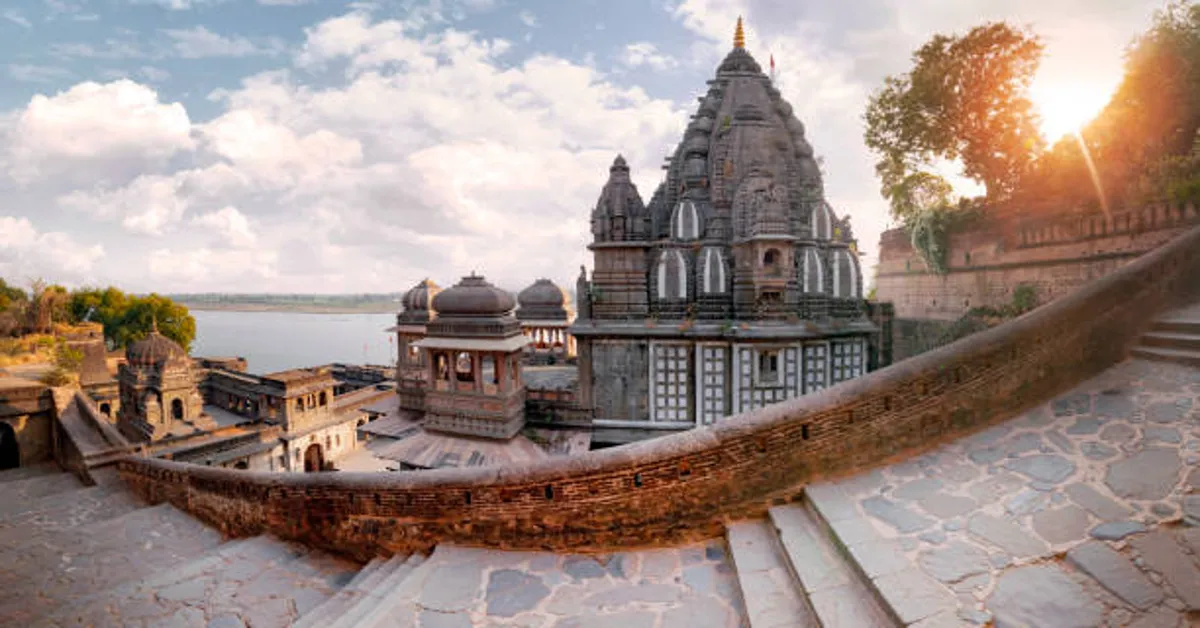India is home to many sacred pilgrimages and ancient practices that continue to thrive amidst modern times. Among these, Narmada Parikrama stands out not only for its spiritual depth but also for its sheer physical and emotional intensity. This centuries-old practice involves walking the complete length of the holy River Narmada, from its origin to its end and back along the opposite bank — a journey steeped in tradition, hardship, and faith. This comprehensive article delves into the Narmada Parikrama route, its significance, stages, traditions, key spiritual spots, travel practices, and the mindset of the pilgrims who undertake this extraordinary journey.
Understanding the Essence of Narmada Parikrama
“Parikrama” in Sanskrit means “circumambulation” — a symbolic act of reverence and surrender. In the case of Narmada Parikrama route, the devotee circumambulates the River Narmada, one of the seven holy rivers of India. Unlike Ganga or Yamuna, the Narmada is not worshipped only through rituals and offerings; instead, devotees show their devotion by physically walking around the entire river without crossing it.
Narmada is believed to be the only river that one does not need to cross for the Parikrama; instead, pilgrims walk along one bank downstream and return upstream on the other. The tradition holds that even Lord Shiva performs Narmada Parikrama route, and thus the journey is believed to burn away sins and elevate the soul.
Typically, the Parikrama spans about 2600 to 3000 kilometers, depending on the chosen path and number of detours. It takes 4 months to 3 years, based on the devotee’s pace and mode — on foot being the most traditional and revered.
Route Overview: From Origin to Ocean and Back
The Narmada originates from Amarkantak, a sacred hill in Madhya Pradesh. It flows westward for over 1300 kilometers, traversing Madhya Pradesh, Maharashtra, and Gujarat, before meeting the Arabian Sea at Bharuch in Gujarat. The Parikrama begins at the origin point in Amarkantak and follows this general route:
1. Amarkantak (Origin) to Bharuch (Mouth) – Downstream on the Right Bank
- Pilgrims start from Amarkantak, where the river emerges from the Maikal hills.
- They walk westward on the southern (right) bank of the river.
- The journey passes through districts like Dindori, Mandla, Jabalpur, Narsinghpur, Hoshangabad, Harda, Khandwa, and Barwani in Madhya Pradesh.
- Entering Maharashtra, the Parikrama continues through Nandurbar.
- It then flows into Gujarat, passing through Kevadiya, Rajpipla, and Bharuch, finally reaching the confluence with the Arabian Sea.
2. Bharuch to Amarkantak – Upstream on the Left Bank
- After paying respects at the mouth of the river, pilgrims begin the return journey on the northern (left) bank.
- This leg includes places like Ankleshwar, Vadodara, and Dabhoi in Gujarat.
- Re-entering Madhya Pradesh, they cross Alirajpur, Dhar, Khargone, Dewas, Sehore, Raisen, Hoshangabad, and Seoni.
- Finally, they return to Amarkantak, completing the full Parikrama.
Important Note on the Path
Pilgrims never cross the river by boat or bridge, except in designated areas where bypassing is not feasible due to lack of connectivity. Any inadvertent crossing is believed to invalidate the spiritual integrity of the Parikrama, and pilgrims often retrace the missed path.
Major Pilgrimage Sites on the Parikrama Route
The Parikrama is dotted with sacred temples, ghats, and ashrams. While every inch of the Narmada is believed to be holy, there are several key pilgrimage spots:
1. Amarkantak
The birthplace of the river and the spiritual gateway of the journey. Pilgrims often stay here for days to prepare spiritually. Key sites include Narmada Kund, Kapildhara Falls, and Ancient Shiva temples.
2. Omkareshwar
One of the twelve Jyotirlingas of Lord Shiva, situated on a river island shaped like the Om symbol. It is a major spiritual stop, and pilgrims spend considerable time here.
3. Maheshwar
A town deeply associated with Ahilyabai Holkar and known for its Shiva temples and ghats. Maheshwar is a blend of architectural beauty and spiritual gravity.
4. Hoshangabad and Nemawar
Situated on opposite banks, both are considered highly sacred. Nemawar is home to the Siddheshwar temple and is a place where many saints meditate.
5. Bharuch
The final point on the downstream route. Here, the river meets the ocean, symbolizing the culmination of life and surrender to the divine.
6. Mandla, Dindori, and Bhedaghat
On the upstream journey, these towns offer lush forests, marble rocks, and spiritual peace, making them important halts for rest and rejuvenation.
7. Chidgaon, Mortakka, and Sahastradhara
Known for natural beauty, waterfalls, and spiritual vibrations. Mortakka also marks a key crossing point if needed.
Traditions and Practices During the Parikrama
The Narmada Parikrama route is not a tourist activity. It is a deeply spiritual practice guided by faith, discipline, and simplicity. Some of the customary practices followed by Parikramavasis (pilgrims) include:
1. Strict Walking Protocol
Pilgrims walk only on foot, though some elderly or disabled pilgrims may use bullock carts. The use of vehicles is discouraged unless absolutely necessary.
2. No River Crossing
As mentioned earlier, the sanctity of the Parikrama lies in not crossing the river until the halfway point is reached and the return journey begins.
3. Ascetic Lifestyle
Pilgrims sleep on the ground, eat satvik food (often donated by villagers or cooked with minimal supplies), bathe in the river daily, and refrain from luxury or indulgence.
4. Chanting and Silence
Chanting “Narmade Har” or “Om Narmadaaya Namah” is common. Some observe maun vrat (vow of silence) for spiritual focus.
5. Respect for Nature and Villagers
Parikramavasis believe that Narmada Maa tests their patience, humility, and compassion. Littering, harming trees, or hurting animals is strictly avoided.
Physical and Mental Challenges on the Route
While the Parikrama is spiritually rewarding, it is physically and emotionally demanding. It tests the endurance, resolve, and humility of the devotee.
Terrain
The route traverses dense forests, riverbanks, rocky paths, farmlands, and urban areas. Weather conditions can range from scorching heat in summer to heavy rain in monsoon, making each leg of the journey unique in its challenge.
Health Risks
Blisters, heat strokes, dehydration, fever, and foot infections are common. Thus, carrying basic first-aid, water purification tablets, and walking gear is essential.
Loneliness and Introspection
Many walk alone or with a small group, which can lead to periods of loneliness. However, this solitude often turns into a meditative state, helping pilgrims reflect deeply on life.
Lack of Amenities
There are long stretches with no restrooms, shops, or shelter. Pilgrims must be self-reliant and resourceful. Yet, the hospitality of villagers often comes as divine intervention.
Modes of Performing Narmada Parikrama Route
There are several ways in which people undertake the journey:
1. Traditional Foot Parikrama
This is the most revered and spiritually potent method. Pilgrims walk continuously for several months, stopping at temples and ashrams.
2. Bullock Cart Yatra
Common among elderly pilgrims. Though not as common today, it was widely used in earlier times.
3. Group Parikrama
Ashrams and spiritual organizations often organize guided Parikramas with logistics support, though purists may view this as less authentic.
4. Partial or Segment Parikrama
Some devotees complete the Parikrama in segments over several years, due to time or health constraints. They resume from where they last stopped.
Timing and Duration of the Parikrama
Most pilgrims begin the journey during Shivratri, Kartik Purnima, or Makar Sankranti, as these are considered auspicious. Avoiding the monsoon is common, given the risk of flooding and slippery terrain. The full Parikrama can take anywhere between 120 days to 3 years, depending on pace, age, health, and devotion.
Cultural and Spiritual Significance
Narmada Parikrama route is not merely a physical act but a transformational pilgrimage. It brings humility, detachment, strength, and inner peace. Along the journey, pilgrims interact with sages, tribal communities, rural farmers, and other seekers. This exposure breaks barriers of caste, class, language, and region, making the experience deeply humanistic and inclusive.
The river is also associated with feminine energy and motherly grace. Many view Narmada as a living goddess who nurtures, protects, and guides those who surrender to her flow.
Preparation Tips for Aspirants
If you’re planning to embark on the Narmada Parikrama route, here are a few essential tips:
- Train physically by walking long distances with a loaded backpack.
- Carry light but essential items – clothes, water filter, first aid, torch, reusable containers, and religious items.
- Learn basic Hindi or local dialects, as rural communication will be frequent.
- Stay mentally flexible and open-hearted; each day brings new challenges and lessons.
- Document your journey, either through writing or voice memos. It will help in reflection and possibly inspire others.
ALSO READ: Facebook VIP Bio Stylish 2022: A Complete Guide to Personality and Prestige on Social Media
FAQs
1. How long does it take to complete the Narmada Parikrama?
The full Narmada Parikrama route typically takes between 4 months and 3 years, depending on the devotee’s walking pace, weather, personal health, and whether the journey is done in a single stretch or segmented over time.
2. Is it necessary to walk the entire route of the Narmada Parikrama?
Yes, traditionally the Parikrama is done on foot, as walking symbolizes devotion, humility, and endurance. Using vehicles is discouraged and seen as reducing the spiritual merit of the pilgrimage.
3. Can one cross the Narmada River during the Parikrama?
No. One of the key rules of Narmada Parikrama is not crossing the river until reaching its endpoint. Devotees walk downstream on one bank and return upstream on the opposite, without switching sides in between.
4. When is the best time to start the Narmada Parikrama route?
The most favorable times to begin the journey are during Kartik Purnima (October-November) or Makar Sankranti (January). Avoid starting during the monsoon due to river swells and difficult walking conditions.
5. Is it safe to do Narmada Parikrama alone?
Yes, many pilgrims undertake the Parikrama alone and find it safe. However, one must stay cautious, alert, and prepared. Walking in groups or with a spiritual organization can offer additional safety and guidance for first-timers.









